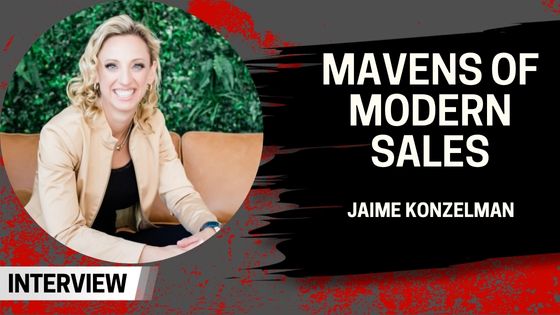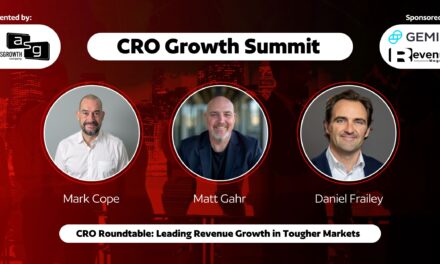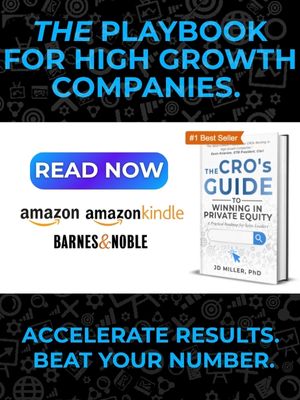
Mavens of Modern Sales – Jaime Konzelman

Welcome to Mavens of Modern Sales, where we take a deep dive with the sales leaders pulling sales teams in the 21st century to get their insights on leadership, strategy, industry trends, and more.
This week we talked to Jaime Konzelman Chief Revenue Officer at Aptum.
You recently posted the 4 key qualities of a valuable leader. If you had to pick one that’s most critical for leadership right now, which would it be and why?
Great question—and while all four qualities of a valuable leader matter, if I had to pick one that’s most critical for leadership right now, it would absolutely be empathy.
In today’s world—where uncertainty, burnout, and complexity are at an all-time high—empathy isn’t just a “soft skill”; it’s a strategic advantage.
I believe empathy within leadership is the glue that connects so many leadership qualities together and to life. Empathy says, “I see you. I am one of you and I can hold space for your growth without judgement.” Through empathy we connect to the emotions and experiences of others and through that process bring humanity and connection back to the forefront of leadership and in moments, when appropriate a little healing and a whole lot of love.
As both an executive coach and a Chief Revenue Officer, I’ve seen firsthand how empathetic leaders create environments where people feel safe, seen, and supported—and that’s where true performance thrives.
Empathy allows leaders to:
- Connect, not just communicate.
It’s not enough to share information or set direction. Empathetic leaders take the time to understand what their people are really experiencing—emotionally, mentally, and practically. This creates trust and psychological safety, which are essential for innovation, resilience, and high performance. - Lead through change with humanity.
Change is constant—new systems, new strategies, shifting market demands. Empathy helps leaders recognize that even positive change can be disorienting. It ensures we don’t bulldoze our teams in pursuit of progress, but instead bring them with us by listening, adapting, and supporting them through the transition. - Navigate diverse perspectives and dynamics.
Today’s workplace is more diverse, global, and multi-generational than ever. Empathy allows leaders to suspend judgment, ask better questions, and truly understand different points of view—which leads to better decisions and more inclusive cultures. - Build loyalty in a world of choice.
Top talent doesn’t just want a paycheck—they want purpose, connection, and to feel like they matter. Leaders who demonstrate empathy create loyalty, not because they’re perfect, but because they’re real. People don’t leave companies—they leave leaders who don’t care. Empathy changes that.
To be clear, empathy isn’t about being soft or avoiding hard conversations. It’s about being present, attuned, and human. It’s about understanding that the best results come through people, not at the expense of them.
In a world that’s changing fast, the most powerful thing a leader can do is slow down long enough to understand and connect with people in a deep intrinsic way and that requires deep, purposeful, empathy.
It seems like a rarity to hear someone acknowledge that not everyone needs to be a leader – How do you support team members who may not want leadership roles but are still critical to the team’s success?
Absolutely, this is a powerful and important question—especially in today’s workplace where leadership is often conflated with people management. As an executive coach and Chief Revenue Officer, I’ve had the privilege of working with a wide range of high-performing individuals, many of whom have no interest in people management roles—and still demonstrate immense value and influence within the organization.
First, let’s reframe what we mean by “leadership.” Leadership isn’t reserved solely for people with direct reports. It’s important to distinguish between leadership domain skills—which reflect thought leadership, subject matter expertise, strategic ownership, and leadership acumen which includes so many individuals skills and attributes—and people management responsibility, which includes developing others, handling performance conversations, and managing team dynamics.
You can be a leader without ever becoming a people manager. I’ve worked with top-performing sales engineers, product marketers, and data analysts who lead through their insight, influence, and executional excellence—not by managing people, but by driving outcomes, elevating conversations, and setting standards.
I believe who you are is how you lead and how you lead is a function of self-awareness regardless if you lead a team of people, or lead initiatives without a team of direct reports. Leadership in that sense is self-leadership. Self-leadership is the foundation of all leadership maturity. It means being accountable for your own mindset, energy, and growth. It means showing up with intention, delivering consistently, and navigating challenges without waiting for direction. When someone owns their space, their craft, and their impact—that’s leadership, full stop.
I support team members who don’t want formal leadership roles:
- Create Career Ladders That Don’t Require People Management
I advocate for dual career tracks—technical or individual contributor (IC) paths that allow people to grow, gain recognition, and increase compensation without taking on direct reports. Leadership maturity and impact should be rewarded at every level. - Recognize and Celebrate Invisible Leadership
Not all leadership is loud or formal. Quiet leaders who drive collaboration, mentor peers, or model operational excellence deserve just as much visibility as traditional managers. I make it a point to highlight those contributions in performance reviews and team settings. - Offer Development Opportunities Without the Pressure to “Climb”
Some people fear that if they say “yes” to a stretch assignment, they’ll get pushed into a management track they don’t want. I normalize growth without hierarchy—encouraging skill-building, cross-functional projects, and strategic thinking for its own sake. - Coach for Clarity and Confidence
Often, people opt out of leadership roles because of a lack of confidence, not capability. Through coaching, we can explore the difference between fear and preference—then align their path to what truly fits. For some, that means saying “no” to management roles with confidence. For others, it means realizing they can lead in a way that feels authentic to them.
At the end of the day, mature leadership cultures honor the full spectrum of contribution, not just the hierarchical kind. It’s our job as executives to make sure that everyone feels seen, supported, and celebrated—whether they manage a team or lead from within it.
You talked about the importance of continuous learning—what’s the top thing you’re focused on training your team on right now, and why?
Right now, my top focus is training our team to harness data, insights, and the power of AI to elevate sales conversations. In today’s market, buyers are more informed, time-starved, and under pressure to deliver measurable outcomes. Simply pitching products isn’t enough—we need to show up as strategic advisors who bring real business intelligence to the table.
By leveraging data and AI-driven insights, our sellers can tailor conversations to what truly matters to stakeholders—whether it’s cost efficiency, risk reduction, or business transformation. This not only builds trust and credibility but also shortens sales cycles and increases our ability to shape larger, more complex deals earlier in the buying process.
We’re not just teaching tools—we’re reshaping the mindset from selling to customers to solving with them. That shift is what drives deal velocity and pipeline growth at scale.
What changes are you seeing in sales over the last couple years and how has that shifted you and your team’s approaches?
Over the last few years, we’ve seen a dramatic shift in B2B sales—driven by buyer behavior, digital transformation, and economic pressure. Buyers now expect hyper-relevance -i.e. value from the first interaction and often prefer a seller-free experience until late in the cycle. They’ve done the research, benchmarked competitors, and come armed with expectations before we ever get in the room.
This has fundamentally changed how we sell. We’ve shifted from pitching products to co-creating solutions. From static sales plays to dynamic, insight-led engagement. And from relationship-first to value-first—where every interaction must demonstrate a deep understanding of the customer’s business, not just our own offerings.
As a result, I’ve focused on transforming our team’s approach:
- Training sellers to lead with data, insights, and business impact
- Embedding AI and tools that help us tailor conversations at scale
- Structuring our go-to-market motions around buyer readiness and deal complexity, not just internal org charts
In short, we’ve stopped selling the way we want to sell and started selling the way buyers want to buy. And that mindset shift has made all the difference.
How often do you take a step back and evaluate your sales team’s strategy, and what key things are you looking for when you do?
Constantly. As a C-suite leader, I believe evaluating your sales strategy isn’t a quarterly exercise—it’s a constant practice. The market is always shifting, and staying effective requires keeping a pulse on what’s changing, what’s no longer working, and where new opportunities are emerging. That means being willing to iterate not just on tactics, but on the strategy itself—and being humble enough not to cling to what once worked if it’s no longer serving us.
I’ve been fortunate in my career to learn under a 4x CRO who truly mastered the art of bridging strategy and execution—while creating space for others to rise, stretch, and accomplish extraordinary results together. That experience shaped my own leadership style.
When I step back and evaluate our strategy, I’m looking at a few key things:
- Are we aligned to today’s buyer and market realities?
- Is our team equipped to sell value, not just features?
- Are we creating the conditions for both performance and growth—for the business and for the people in it?
My ability to stay hyper-focused on long-term strategy while staying agile in the face of change is something I credit directly to those career lessons. Strategy is never static—it’s a living, evolving muscle we flex daily.
What’s a skill you find most important for a seller to start learning if they want to grow into a leadership role?
One of the most important skills a seller can develop to grow into leadership is the ability to move from insight to action—and to clearly articulate their point of view.
It’s one thing to spot a trend or gather data. It’s another to synthesize that into a perspective, make a decision, and lead others toward it. The best future leaders don’t just observe—they activate. They know how to turn complexity into clarity, and clarity into momentum.
But here’s the truth: moving from insight to action isn’t a one-time lesson—it’s a practice. Like an athlete drills foundational skills until they become second nature, this ability must be built through repetition. It requires developing the kind of muscle memory and mental aperture that allows you to bring your ideas to life—even in the most volatile and fast-evolving business environments.
The sellers who rise are the ones who not only learn this skill—but live it.
Lastly, we like to ask everyone we talk to, what is your favorite career oriented resource, book, tool, or podcast and why?
As an executive coach and lifelong learner, I’ve spent years developing frameworks, tools, and coaching programs designed to help people accelerate their growth—both personally and professionally. That body of work is a direct result of my own journey: navigating high-stakes environments, learning through failure, and evolving through experience.
I created the resources I wish I had earlier in my career—tools that help leaders build self-awareness, communicate with impact, lead through complexity, and turn insight into action. And what’s most fulfilling is seeing those tools empower others to rise, take ownership of their path, and grow in ways they never thought possible.
That said, I still pull inspiration from everywhere—from books like Quiet Leadership to The Body Keeps the Score to content from thought leaders like Brené Brown, Simon Sinek and the plethora of workshops I’ve participated in over the years. Lately, I’m leaning into leaning modalities that may seem esoteric but are incredibly powerful in leadership and corporate arena – things like breathwork and somatic healing principles. At the end of the day, I believe your most powerful resource is the one you build for yourself—and then share with others.
Jaime Konzelman is a powerhouse C-suite executive with deep business acumen and an acute ability to transform complex data and market dynamics into commercial strategies that accelerate growth. With over two decades of experience, she has led revenue transformation across diverse sectors—from Private Equity-backed ventures and hospitality to casino gaming and IT managed services. Her career spans companies from the fortune 500 to 1000 roster including PE-backed growth stage, global services firms. Jaime’s cross-industry fluency and strategic precision have made her a sought-after growth catalyst for companies seeking to unlock new market value and commercial performance.
































